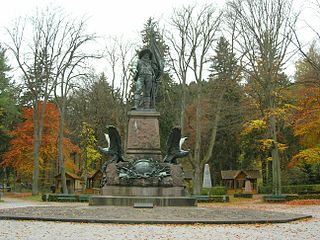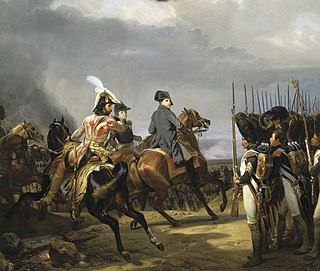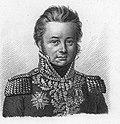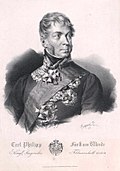This is the complete order of battle of the French and Third Coalition armies during the Battle of Austerlitz.

The Battle of Elchingen, fought on 14 October 1805, saw French forces under Michel Ney rout an Austrian corps led by Johann Sigismund Riesch. This defeat led to a large part of the Austrian army being invested in the fortress of Ulm by the army of Emperor Napoleon I of France while other formations fled to the east. Soon afterward, the Austrians trapped in Ulm surrendered and the French mopped up most of the remaining Austrians forces, bringing the Ulm Campaign to a close.

The Battle of Teugen-Hausen or the Battle of Thann was an engagement that occurred during the War of the Fifth Coalition, part of the Napoleonic Wars. The battle was fought on 19 April 1809 between the French III Corps led by Marshal Louis-Nicolas Davout and the Austrian III Armeekorps commanded by Prince Friedrich Franz Xaver of Hohenzollern-Hechingen. The French won a hard-fought victory over their opponents when the Austrians withdrew that evening. The site of the battle is a wooded height approximately halfway between the villages of Teugn and Hausen in Lower Bavaria, part of modern-day Germany.
This is an order of battle of the French and German Armies at the beginning of the Franco-Prussian War in 1870.

The Austro-Polish War or Polish-Austrian War was a part of the War of the Fifth Coalition in 1809. In this war, Polish forces of the Napoleon-allied Duchy of Warsaw and assisted by forces of the Kingdom of Saxony, fought against the Austrian Empire. By May, the Russian Empire joined against Austria. Polish troops withstood the Austrian attack on Warsaw defeating them at Raszyn, then abandoned Warsaw in order to reconquer parts of pre-partition Poland including Kraków and Lwów, forcing the Austrians to abandon Warsaw in futile pursuit.

In the Battle of Hohenlinden on 3 December 1800, a French army commanded by Jean Victor Marie Moreau decisively defeated the army of Habsburg Austria led by Archduke John. The first action of the campaign was the Battle of Ampfing, two days earlier. After Hohenlinden there was a series of rearguard clashes beginning on 9 December at Rosenheim and continuing from the 14th through the 20th at Salzburg, Neumarkt am Wallersee, Frankenmarkt, Schwanenstadt, Vöcklabruck, Lambach, and Kremsmünster. During the retreat, the Austrian army began a process of disintegration and an armistice was concluded a few days later.
In the Battle of Sankt Michael on 25 May 1809, Paul Grenier's French corps crushed Franz Jellacic's Austrian division at Sankt Michael in Obersteiermark, Austria. The action occurred after the initial French victories during the War of the Fifth Coalition, part of the Napoleonic Wars. Sankt Michael is located approximately 140 kilometers southwest of Vienna.

Caldiero 1805 Order of Battle

The Battle of Verona was fought on 18 October 1805 between the French Army of Italy under the command of André Masséna and an Austrian army led by Archduke Charles, Duke of Teschen. By the end of the day, Massena seized a bridgehead on the east bank of the Adige River, driving back the defending troops under Josef Philipp Vukassovich. The action took place near the city of Verona in northern Italy during the War of the Third Coalition, part of the Napoleonic Wars.

The Battle of Graz took place on 24–26 June 1809 between an Austrian corps commanded by Ignaz Gyulai and a French division led by Jean-Baptiste Broussier. The French were soon reinforced by a corps under Auguste Marmont. The battle is considered a French victory though Gyulai was successful in getting supplies to the Austrian garrison of Graz before the two French forces drove him away from the city. Graz, Austria is located 145 kilometers south-southwest of Vienna at the intersection of the modern A2 and A9 highways.

The Battle of Neumarkt-Sankt Veit on 24 April 1809 saw a Franco-Bavarian force led by Marshal Jean-Baptiste Bessières face an Austrian Empire army commanded by Johann von Hiller. Hiller's numerically superior force won a victory over the Allied troops, forcing Bessières to retreat to the west. Neumarkt-Sankt Veit is located ten kilometers north of Mühldorf and 33 kilometers southeast of Landshut in Bavaria.

At the beginning of the War of the Fifth Coalition on 9 April 1809, the armies of the Austrian Empire invaded the Kingdom of Bavaria, an ally of the First French Empire, and the Kingdom of Italy, a French satellite. After Austria's defeat in the War of the Third Coalition the County of Tyrol and the Vorarlberg were ceded to Bavaria in the Fourth Peace of Pressburg on 26 December 1805. Angry at the imposition of Bavarian laws and conscription, the Tyrolese rebelled in support of Austria. During the first week, local irregular forces killed or captured the main Bavarian garrison and also forced a French force to capitulate.
The Battle of Sacile saw the Franco-Italian Army of Italy commanded by Eugène de Beauharnais face the Archduke John of Austria's Army of Inner Austria during the War of the Fifth Coalition. Believing that he was only opposed by the Austrian VIII Armeekorps, Eugène launched his right wing in a heavy attack against it. In the morning, the Austrians successfully held off Franco-Italian assaults on their left flank as Eugène reinforced the attack with troops from his left wing. Later in the day, John counterattacked Eugène's weakened left wing with the IX Armeekorps, forcing the Franco-Italian army to withdraw from the battlefield. The battle at Sacile was preceded by the action of Pordenone on 15 April in which the Austrian advance guard mauled the French rear guard. The Austrian victory compelled Eugène to retreat to the Adige River at Verona where he gathered reinforcements and planned a counteroffensive.

The Jena-Auerstedt Campaign Order of Battle is listed below. The order of battle includes units from the First French Empire and the Kingdom of Prussia that fought each other in the campaign that included the decisive Battle of Jena-Auerstedt on 14 October 1806. The order of battle may be useful to trace the battles of Schleiz and Saalfeld, which occurred before Jena-Auerstedt, as well as battles and capitulations that happened after 14 October, such as Erfurt, Halle, Prenzlau, Pasewalk, Stettin, Waren-Nossentin, and Lübeck.
The Dalmatian Campaign saw several battles fought between 30 April and 21 May 1809 by Auguste Marmont's First French Empire soldiers and Andreas von Stoichevich's Austrian Empire troops. The Austrians drove the French from their positions on the Zrmanja River at the end of April. But in mid-May, the French counterattack forced back the Austrians. The defenders offered stout resistance, but ultimately Marmont broke out of Dalmatia and joined Emperor Napoleon's army near Vienna with over 10,000 men. The campaign was fought during the War of the Fifth Coalition, part of the Napoleonic Wars. Dalmatia is part of the modern-day nation of Croatia.
The Battle of Linz-Urfahr on 17 May 1809 saw soldiers from the Austrian Empire fighting against troops from two of Emperor Napoleon's allies, the Kingdom of Württemberg and the Kingdom of Saxony. An Austrian corps led by Feldzeugmeister Johann Kollowrat attacked General of Division Dominique Vandamme's Württembergers who held a fortified bridgehead on the north bank of the Danube opposite the city of Linz. As the combat got underway, Saxons led by Marshal Jean-Baptiste Bernadotte began reinforcing the defenders. This prompted Kollowrat to order a retreat, which was followed up by Napoleon's German allies.
The Piave River 1809 Order of Battle shows the units and organization for the Franco-Italian and Austrian Empire armies that fought in the Battle of Piave River on 8 May 1809. Eugène de Beauharnais, the viceroy of the Kingdom of Italy defeated Archduke John of Austria. Eugène's Advance Guard crossed the river first and was assailed by Austrian cavalry and artillery. The French cavalry routed the opposing cavalry and captured 14 enemy guns. A lull followed as John arranged his infantry in a formidable defensive position. Meanwhile, Eugène struggled to pour reinforcements into the bridgehead as the Piave rose dangerously. In the afternoon, the viceroy sent Paul Grenier to drive back the Austrian left while Jacques MacDonald mounted an assault on the center. The attack succeeded in breaking the Austrian line and compelling John to order a retreat.
The VII Corps of the Grande Armée was the name of a French military unit that existed during the Napoleonic Wars. It was formed in 1805 and assigned to Marshal Pierre Augereau. From 1805 through 1807, Augereau led the army corps in the War of the Third Coalition and the War of the Fourth Coalition. It was disbanded after being nearly wiped out at the Battle of Eylau in February 1807 and its surviving troops were distributed to other army corps. At the end of 1808, the VII Corps was reconstituted in Catalonia during the Peninsular War and Laurent Gouvion Saint-Cyr was given command. The corps fought in Spain until 1811, when it was renamed the Army of Catalonia. At that time it was again led by Augereau.






























